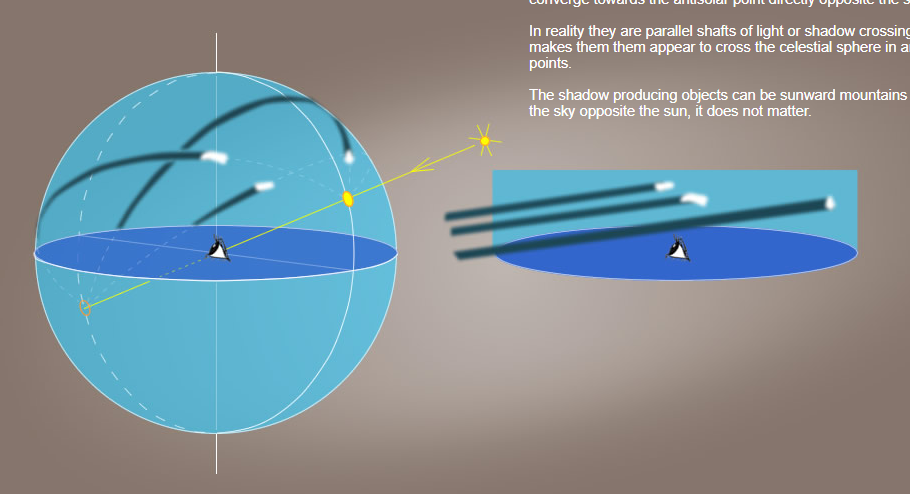OPOD - Anticrepuscular or Antisolar
OPOD - Anticrepuscular or Antisolar: A Phenomenon of Parallel Shafts of Light
Have you ever witnessed a captivating display of rays converging towards a point opposite the sun, seemingly intersecting the celestial sphere? This intriguing atmospheric optics phenomenon is known as Anticrepuscular or Antisolar Rays. Although they appear to converge towards the antisolar point, which lies directly opposite the sun and usually below the horizon, these rays are, in fact, parallel shafts of light or shadow crossing the sky.
The name "Anticrepuscular" is derived from the Latin word "crepusculum," meaning twilight. However, many argue that a more fitting name for this spectacle would be "antisolar rays," as they appear to emanate from the antisolar point. These rays can be observed when the sun is low on the horizon, casting its rays through gaps in clouds or around mountains. The perspective created by our vision makes them appear to cross the celestial sphere in arcs intersecting the sun and antisolar points.
It's fascinating to note that the objects casting shadows that produce these rays can be either sunward mountains or clouds, or even clouds located opposite the sun. The phenomenon does not discriminate based on the position of the shadow-casting objects. This means that whether it is a towering mountain peak or a fluffy cloud, if it creates a shadow that intersects with the parallel shafts of light, it will contribute to the mesmerizing display of anticrepuscular rays.
The occurrence of anticrepuscular rays is not limited to a specific geographical location. These atmospheric marvels can be observed worldwide, provided the conditions are right. However, certain factors such as cloud cover, the angle of the sun, and the presence of suitable shadow-casting objects play a crucial role in their visibility. Therefore, they may not be as frequently observed in some regions compared to others.
To fully appreciate the beauty of anticrepuscular rays, it is essential to understand the concept of perspective. Our eyes perceive the parallel shafts of light as converging due to the way our brain interprets the visual information. This convergence creates an illusion of the rays intersecting at a specific point in the sky. The antisolar point, which lies directly opposite the sun, becomes the focal point for this convergence, adding to the mystique of the phenomenon.
The scientific explanation behind the formation of anticrepuscular rays lies in the interaction between sunlight and atmospheric particles. As sunlight passes through gaps in clouds or around objects, it scatters and interacts with tiny particles in the atmosphere. This scattering causes the rays to become visible, creating the striking effect of parallel shafts of light cutting across the sky. The phenomenon is similar to the more well-known crepuscular rays, which occur when sunlight passes through gaps in clouds on the same side as the sun.
In conclusion, anticrepuscular or antisolar rays are a captivating atmospheric optics phenomenon that offers a mesmerizing display of parallel shafts of light converging towards the antisolar point. Whether they are cast by sunward mountains or clouds, or even clouds located opposite the sun, these rays provide a visual treat for those fortunate enough to witness them. Understanding the role of perspective and the interaction between sunlight and atmospheric particles helps unravel the mystery behind this awe-inspiring phenomenon. So, keep your eyes to the sky, and you may just catch a glimpse of nature's artistry on display.

Anticrepuscular/Antisolar Rays imaged near Cape Town, South Africa by Jonathan Shock. The rays converge towards the shadow of his camera. ©Jonathan Shock, shown with permission

Anticrepuscular rays and shadows might better be called antisolar rays. They appear to converge towards the antisolar point directly opposite the sun and usually below the horizon.
In reality they are parallel shafts of light or shadow crossing the sky. Instead, perspective makes them them appear to cross the celestial sphere in arcs intersecting the sun and antisolar points.
The shadow producing objects can be sunward mountains or clouds or they can be clouds in the sky opposite the sun, it does not matter.
Note: this article has been automatically converted from the old site and may not appear as intended. You can find the original article here.
Reference Atmospheric Optics
If you use any of the definitions, information, or data presented on Atmospheric Optics, please copy the link or reference below to properly credit us as the reference source. Thank you!
-
<a href="https://atoptics.co.uk/blog/opod-anticrepuscular-or-antisolar/">OPOD - Anticrepuscular or Antisolar</a>
-
"OPOD - Anticrepuscular or Antisolar". Atmospheric Optics. Accessed on November 26, 2024. https://atoptics.co.uk/blog/opod-anticrepuscular-or-antisolar/.
-
"OPOD - Anticrepuscular or Antisolar". Atmospheric Optics, https://atoptics.co.uk/blog/opod-anticrepuscular-or-antisolar/. Accessed 26 November, 2024
-
OPOD - Anticrepuscular or Antisolar. Atmospheric Optics. Retrieved from https://atoptics.co.uk/blog/opod-anticrepuscular-or-antisolar/.